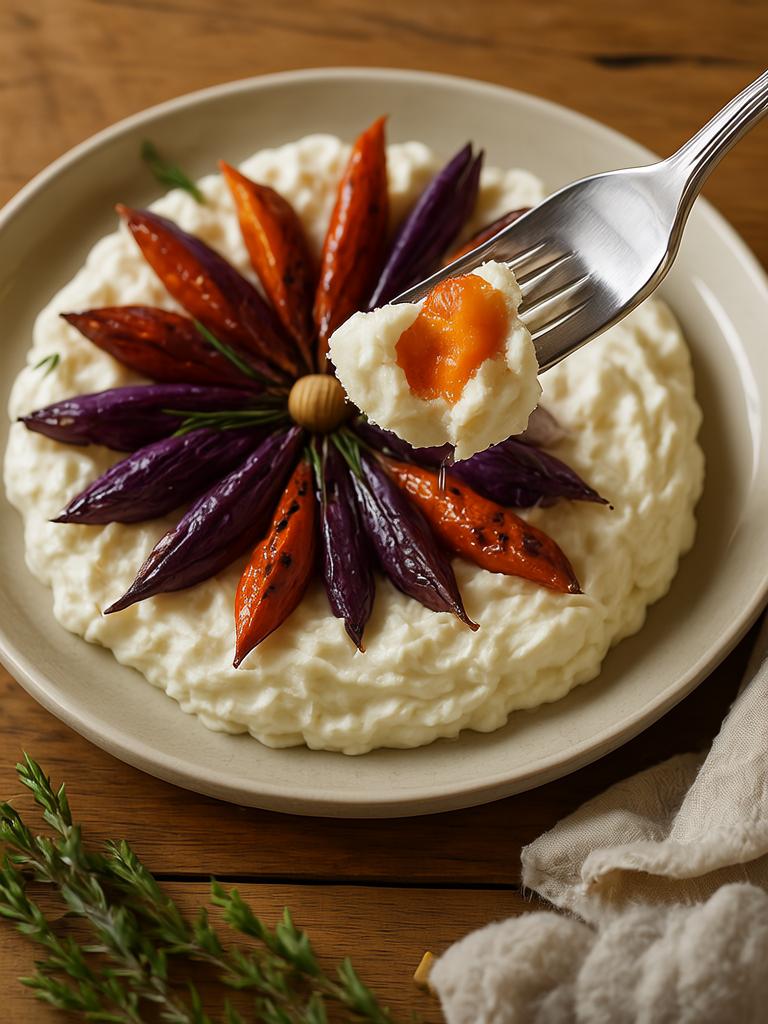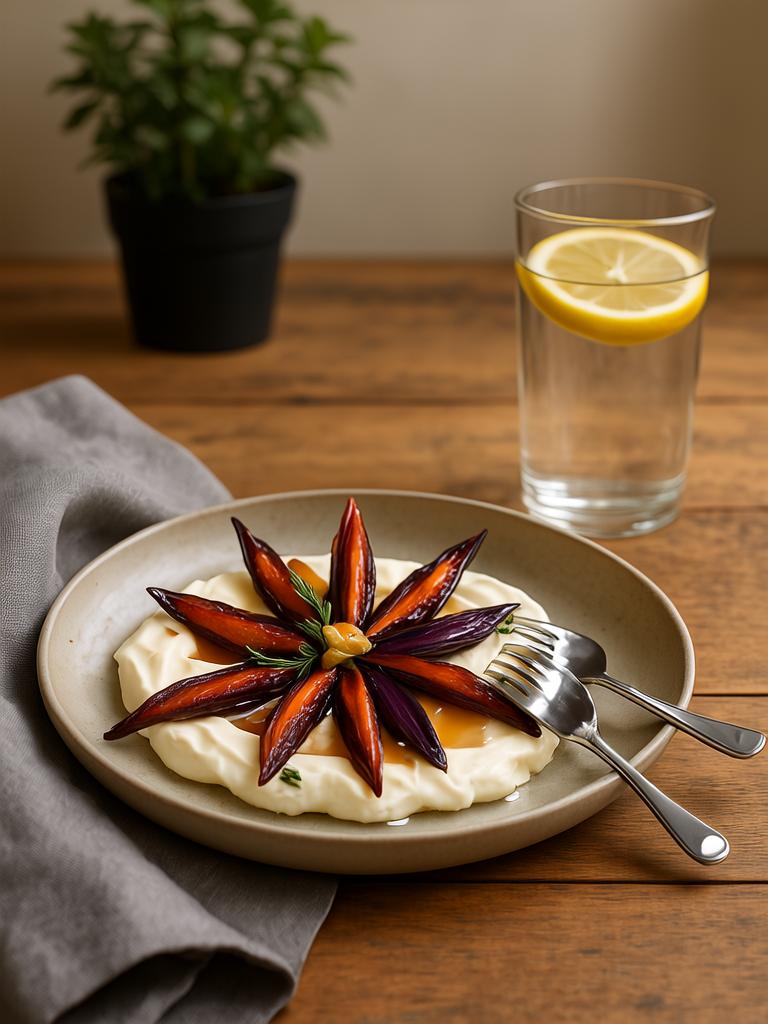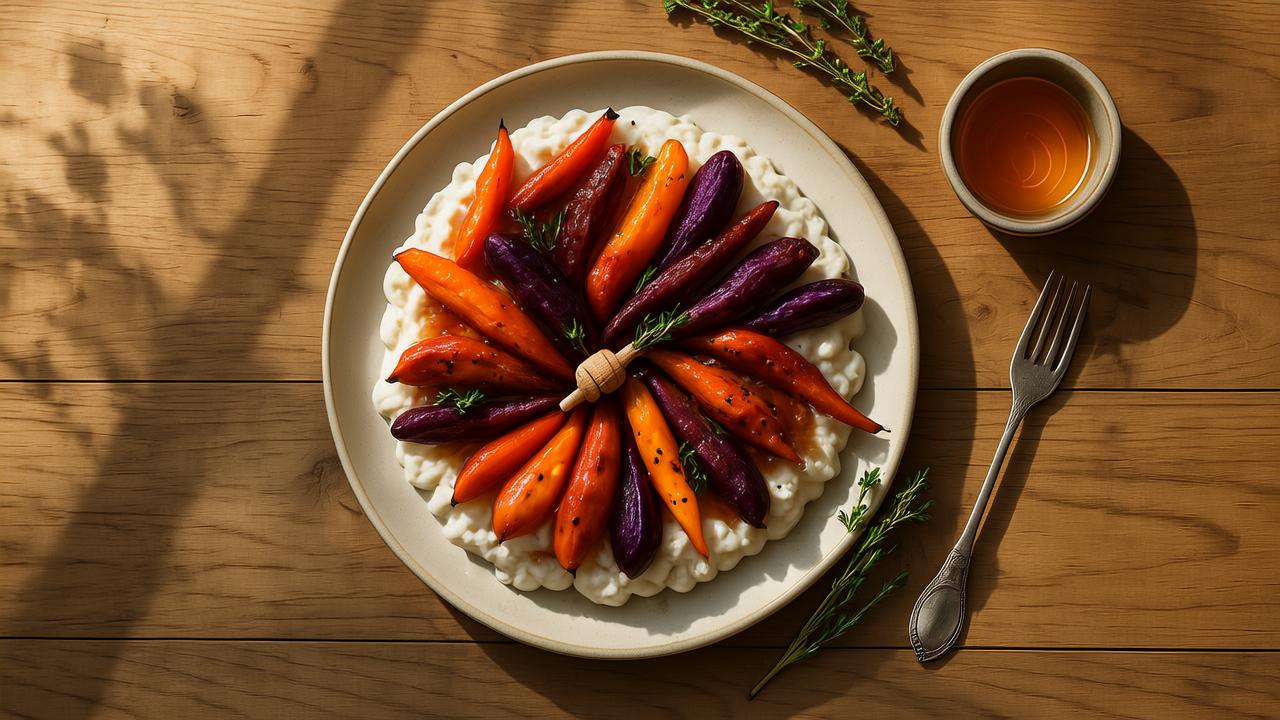There’s something quietly revolutionary happening on the plate, and no, it’s not some new lab-grown meat. It’s carrots. Carrots, whipped ricotta, and a drizzle of hot honey that doesn’t just tap your tastebuds—it sings jazz. This dish, once a humble side, now headlines menus in Michelin-starred kitchens. But why? And how the hell did we get here?
This article dives deep into the technique, the ingredients, the science, and the culinary evolution behind Roasted Carrots with Whipped Ricotta and Hot Honey. Whether you’re running a fine-dining kitchen, crafting elevated small plates, or just obsessed with new-wave vegetable cookery, this one’s for you.
Why This Dish Works (And Works So Damn Well)
Flavor theory. That’s where it starts. Roasting brings out the natural sugars in carrots, deepening their flavor and turning their sweetness into something closer to umami. Then, contrast it. The cool, pillowy ricotta hits the back of your tongue like a velvet hammer. Now finish with heat—both thermal and spicy. Hot honey slices through with a zip of acid, sweetness, and a flick of fire.
This dish is a masterclass in balance:
- Sweet (carrots + honey)
- Creamy (ricotta)
- Spicy (chili infusion in honey)
- Earthy (carrot skin left intact, roasted just shy of burn)
- Acidic (lemon zest or vinegar, if you do it right)
And texture? It’s ridiculous. Tender carrots with just enough resistance, creamy clouds of cheese, and a glossy drizzle that sticks to everything like a good sauce should.
The History: Carrots, Cheese, and Heat
Let’s get nerdy for a minute. Carrots have been cultivated for over 5,000 years, originally grown not for the root but for their leaves and seeds. The orange variety? That didn’t show up until the 17th century in the Netherlands.
Ricotta, meanwhile, has roots in Roman times. It’s a whey cheese—technically a by-product—but when whipped with olive oil, salt, and a touch of lemon, it becomes rich enough to star in any modern dish.
Hot honey is the new kid here. Mike Kurtz started selling it on Brooklyn pizzas in the 2010s. Now it’s everywhere. On fried chicken, roasted veggies, even gelato. What was once niche is now culinary currency.
So when chefs started layering these three elements together, it wasn’t by accident. It was a convergence. The sweet-savory-heat combo satisfies multiple regions of the tongue. Sensory overload, in the best way.

Ingredient Selection: Sourcing Matters More Than You Think
If you think all carrots taste the same, we need to talk.
Go to a farmer’s market and try purple, yellow, and white heirloom carrots side by side. Some are grassy, others almost floral. The sugar content in a fresh-picked carrot can be double that of a mass-produced one. That means deeper caramelization, bolder flavor, and more complexity.
Buy whole carrots with tops still attached. Not only are they fresher, but the tops tell you a lot—if they’re wilted or slimy, walk away. Scrub them clean, leave the skins. The skin has flavor.
For the ricotta: do not—do not—use the grocery store tub unless it’s your only option. Fresh ricotta from a local cheesemaker or deli has more texture and a natural sweetness that elevates the entire dish. If you’ve got time, make your own with whole milk, lemon juice, and patience.
As for the hot honey: infuse it yourself. Store-bought works in a pinch, but DIY means you control the burn. Simmer honey gently with chili flakes (Kashmiri or Calabrian are beautiful choices), then cool and strain. Don’t overdo it—too hot and it bulldozes the other flavors.
Technique: It’s Not Roasting, It’s Engineering
Preheat your oven to 425°F (218°C). That’s your starting point. Not 375. Not 400. You want the Maillard reaction, and that happens when surfaces get hot and stay hot.
Cut the carrots lengthwise, especially the thick ones, but don’t go crazy with uniformity. A little unevenness gives you varied textures. Some bits crispy, others silky.
Toss them with olive oil, kosher salt, and a touch of brown sugar. Optional, but it helps develop that edge-of-burn caramelization. Roast on a sheet pan with space between each carrot—if they touch, they steam, not roast. Let ‘em get those brown, sticky edges. That’s flavor. That’s everything.
Now the ricotta. Use a food processor. Blend with a glug of good olive oil, salt, pepper, and a dash of lemon zest. It should be smooth, but not runny. Like a savory cloud.
Build the plate: smear the ricotta with the back of a spoon, pile on the hot carrots, then zigzag hot honey like you’re painting chaos. Top with flaky salt, crushed pistachios, or microgreens if you’re feeling fancy.
Real-World Application: Why Chefs Are Obsessed
Let’s look at a few examples.
At Lilia in Brooklyn, Chef Missy Robbins pairs roasted root veg with creamy bases on several seasonal dishes. Her secret? Keeping things simple and letting texture do the work.
At Girl & the Goat in Chicago, Stephanie Izard introduced spicy-sweet sauces on roasted veg long before it was trendy. Her dishes showed the world that vegetables weren’t just sides—they could be the damn main event.
Across kitchens in Los Angeles, Copenhagen, and Melbourne, similar iterations are showing up: carrots treated like steak, cheese treated like sauce, honey turned up to eleven.
This dish plays well as a starter, a shared plate, or a veg-forward entrée. Add farro, quinoa, or even roasted chickpeas for heft. Want protein? Toss in crisped pancetta or a poached egg. It flexes.
The Science Behind the Flavor
Carrots are rich in natural sugars—sucrose, glucose, fructose—which convert during roasting. The Maillard reaction starts at about 300°F (149°C), where amino acids and reducing sugars produce that beautiful brown crust.
Ricotta provides milk proteins and fats that coat the mouth, enhancing perceived sweetness and balancing any bitterness in the carrots.
Capsaicin in chili-infused honey activates pain receptors, not just taste buds. That small element of “burn” heightens sensory response across the palate, making other flavors pop. That’s why a drizzle of hot honey doesn’t just add spice—it changes how the entire dish is perceived.
Common Mistakes That Ruin the Dish
- Undercooked carrots: Nobody wants crunchy carrots in a dish that’s meant to melt.
- Overcrowding the pan: Steamed carrots are fine, but not here.
- Bad ricotta: Store-bought tubs lack soul. If it looks like wet cottage cheese, it’ll taste like disappointment.
- Dull honey: Cheap honey tastes like sugar syrup. Local, raw honey adds floral complexity that mass-market stuff just doesn’t deliver.
- Skipping salt: Yes, even for honey. A pinch of salt in the hot honey rounds out the flavor and makes it sing.
Emerging Trend: Veg-Forward, Flavor-First
There’s a shift happening in the culinary world. Diners are leaning into vegetables not because they have to—but because they want to. Dishes like roasted carrots with whipped ricotta and hot honey are part of that evolution. They’re indulgent but wholesome. Familiar yet inventive.
Restaurants that once relegated carrots to soup or slaw are now showcasing them on tasting menus. Plant-based doesn’t mean boring anymore. It means opportunity.

Final Thoughts: What This Dish Teaches Us
If there’s one takeaway here, it’s this: technique transforms humble ingredients into headliners. Roasted carrots. Cheese. Honey. Three basic things. But treated with respect, intention, and a little heat? They become art.
For professionals, this dish is more than just a recipe—it’s a framework. A model for building complex, beautiful food from simple roots. It asks: What if vegetables were more than just sides?
And then it answers: Hell yes, they can be.
Try it. Tweak it. Serve it. You’ll see.
This isn’t just roasted carrots anymore. This is modern cookery. Bold, balanced, and blisteringly good.
FAQs
What makes roasted carrots with whipped ricotta and hot honey so special?
It’s the perfect balance of sweet, spicy, creamy, and earthy flavors with killer texture.
Can I use store-bought ricotta for this recipe?
You can, but fresh or homemade ricotta gives much better flavor and texture.
What’s the best type of carrot to use?
Heirloom or freshly harvested carrots with tops on are ideal for depth of flavor.
How do I make hot honey at home?
Simmer honey with chili flakes, cool, strain, and boom—you’ve got it.
Can I roast carrots with the skin on?
Yes, keep the skin—it adds earthiness and better caramelization.
What temperature is best for roasting carrots?
425°F is perfect to achieve deep browning and concentrated flavor.
Can I make this dish ahead of time?
Yes, roast carrots and whip ricotta ahead; reheat and assemble when ready.
What are good toppings or garnishes?
Flaky salt, crushed nuts, microgreens, or lemon zest work great.
Is this dish vegetarian?
Yes, it’s completely vegetarian unless you add meat toppings.
Can this dish be a main course?
Absolutely—just add grains or protein to make it heartier.

Mariana is a passionate home cook who creates delicious, easy-to-follow recipes for busy people. From energizing breakfasts to satisfying dinners and indulgent desserts, her dishes are designed to fuel both your body and hustle.
When she’s not in the kitchen, she’s exploring new flavors and dreaming up her next recipe to share with the Foodie Hustle community.

